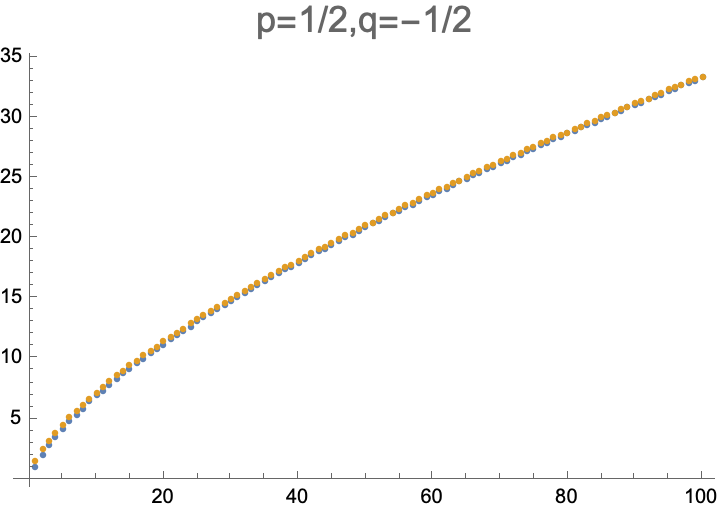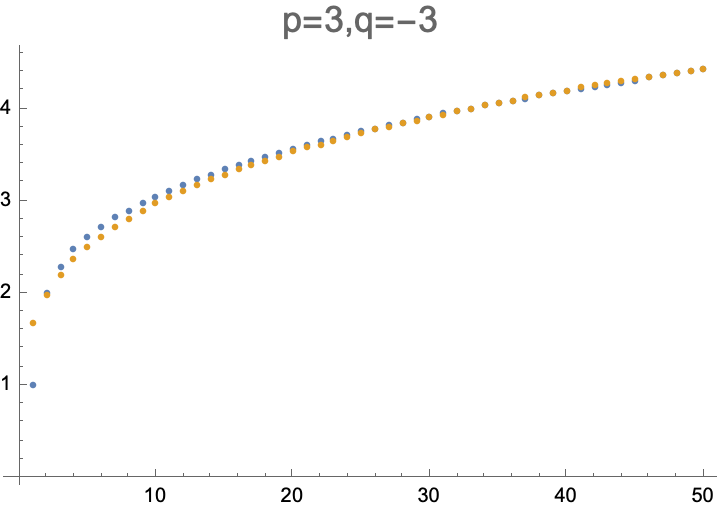Recently, I encountered this problem:
"Given a sequence of positive number $(x_n)$ such that for all $n$,
$$x_{n+1}=x_n+\frac{n}{x_1+x_2+\cdots+x_n}$$
Find the limit $\lim_{n \rightarrow \infty} \frac{x_n}{\sqrt{n}}.$"
As pointed out in the comment section of the following topic [1], this problem is indeed open. Out of curiosity, I wonder if this problems has a research-level meaning? For example, does it stem from an interesting system dynamic question?
I'm aware this question might not suitable for Mathoverflow forum, but aside from this site, I don't think there is a more suitable place to ask this question
-
$\begingroup$ There is nothing in the thread you linked to that suggests this problem is open. $\endgroup$– Steven LandsburgCommented Jul 9, 2022 at 23:25
-
1$\begingroup$ @StevenLandsburg one comment links to link.springer.com/book/10.1007/978-3-030-77139-3 and says this problem is a special case of something in a section of open problems numbered 1.30. As the book is about "ingenious computations" in contests, I suspect this problem can be solved some clever way $\endgroup$– Will JagyCommented Jul 9, 2022 at 23:36
-
3$\begingroup$ The open question seems to be proving that the limit exists (which is needed for the validity of the derivation of the limit's value). $\endgroup$– Noam D. ElkiesCommented Jul 9, 2022 at 23:37
-
1$\begingroup$ @NoamD.Elkies: That thread establishes that there exists a person who does not know how to determine whether the limit exists. This seems to be necessary, but not sufficient, for the question to be open. $\endgroup$– Steven LandsburgCommented Jul 10, 2022 at 1:14
-
3$\begingroup$ Given that this comes from a contest-problem-related source and then seems contest-problem-y, I would guess that where this problem comes from is very similar to where contest problems come from. But then I realized that I don't really know how contest problems are usually written. $\endgroup$– Will SawinCommented Jul 10, 2022 at 1:41
2 Answers
The OP asks where this recursion relation might appear in a research context. It appears as a discretization of the Emden–Fowler nonlinear differential equation, $$f''(t)=t^{p}[f(t)]^q,$$ for $p=1$, $q=-1$. A particular solution is $$f(t)=\lambda t^{(p+2)/(1-q)},\;\;\lambda=\left[\frac{(p+2)(p+q+1)}{(q-1)^2}\right]^{1/(q-1)}.$$ One readily checks that the asymptotic limit $x_n\rightarrow \sqrt{3n}$ for $x_n=f'(n)$ is obtained for $p=1$, $q=-1$.
This connection to the Emden-Fowler equation motivates the following
Conjecture: The recursion relation
$$x_{n+1}=x_n+n^{p}(x_1+x_2+\cdots+x_n)^q$$
has for $p\geq 0$, $q\leq 0$, $p+q>-1$, the limit
$$\lim_{n\rightarrow\infty}n^{(1-q)/(1+p+q)}x_n=\frac{p+2}{1-q}\left[\frac{(p+2)(p+q+1)}{(q-1)^2}\right]^{1/(q-1)}.$$
For $q=-1$ this is stated as an open problem on page 11 of Sequences of Real Numbers, by Sîntămărian & Furdui.
Here are two numerical tests (blue is the recursion for $x_n$, gold the conjectured large-$n$ asymptotic):


-
$\begingroup$ By "that theorem", did you mean Stolz-Cesàro's? Would you mind clarifying this point? Because, I think the crucial part of this problem is to prove the existence of the limit. Nonetheless, to the best of my knowledge, Stolz-Cesàro's cannot show that. $\endgroup$ Commented Jul 10, 2022 at 7:26
-
$\begingroup$ Carlo, it is in a book by the same pair of authors that the suggestion of "open problem" comes up. Called Sharpening Mathematical Analysis Skills. Also, in a section 1.30 called "Open Problems," where this problem is a special case of the "open" problem specified there. I would be happy just to see the relevant page. $\endgroup$ Commented Jul 10, 2022 at 13:10
-
-
-
1$\begingroup$ @ParesseuxNguyen --- indeed, I would not know how to prove the existence of the limit from the SC theorem; I have removed that sentence. $\endgroup$ Commented Jul 10, 2022 at 13:40
This is to prove the conjecture \begin{equation*} x_n\sim\sqrt3\,n^{1/2} \tag{1}\label{1} \end{equation*} (as $n\to\infty$).
(For all integers $n\ge1$,) we have \begin{equation*} h_n:=x_{n+1}-x_n=\frac n{s_n}, \tag{2}\label{2} \end{equation*} where \begin{equation*} s_n:=x_1+\cdots+x_n, \end{equation*} with $s_0:=0$. Rewrite \eqref{2} as $s_{n+1}-2s_n+s_{n-1}=\dfrac n{s_n}$ and then as $s_{n+1}s_n-2s_n^2+s_{n-1}s_n=n$ and then as $s_{n+1}(s_{n+1}-x_{n+1})-2s_n^2+s_{n-1}(s_{n-1}+x_n)=n$ and then as $s_{n+1}^2-2s_n^2+s_{n-1}^2=n+s_{n+1}x_{n+1}-s_{n-1}x_n$. Note also that $s_{n+1}x_{n+1}-s_{n-1}x_n=s_n(x_{n+1}-x_n)+x_{n+1}^2+x_n^2=n+x_{n+1}^2+x_n^2$, by \eqref{2}. So, \begin{equation*} t_n:=s_{n+1}^2-2s_n^2+s_{n-1}^2=2n+x_{n+1}^2+x_n^2. \tag{3}\label{3} \end{equation*}
It follows that \begin{equation*} t_n\ge2n. \tag{4}\label{4} \end{equation*} Suppose that \begin{equation*} t_n\gtrsim cn \tag{5}\label{5} \end{equation*} for some real $c>0$. As usual, for any two positive sequences $(a_n)$ and $(b_n)$, we write $a_n\lesssim b_n$ or, equivalently, $b_n\gtrsim a_n$ to mean $a_n\le(1+o(1))b_n$ -- so that $(a_n\lesssim b_n\ \&\ a_n\gtrsim b_n)\iff a_n\sim b_n\iff a_n=(1+o(1))b_n$.
By \eqref{3}, the $t_n$'s are the second (symmetric) differences of the $s_n^2$'s. So, by \eqref{5},
\begin{equation*}
s_n^2\gtrsim\frac c6\,n^3\quad\text{and hence}\quad s_n\gtrsim\sqrt{\frac c6}\,n^{3/2}. \tag{6}\label{6}
\end{equation*}
So, by \eqref{2},
\begin{equation*}
h_n\lesssim \sqrt{\frac6c}\,n^{-1/2} \quad\text{and hence}\quad
x_n\lesssim \sqrt{\frac6c}\,2n^{1/2}. \tag{7}\label{7}
\end{equation*}
So, by \eqref{3},
\begin{equation*}
t_n\lesssim 2n+2\frac6c\,4n=\Big(2+\frac{48}c\Big)n. \tag{8}\label{8}
\end{equation*}
So (cf. \eqref{6}),
\begin{equation*}
s_n^2\lesssim\Big(2+\frac{48}c\Big)\frac{n^3}6
=\Big(\frac13+\frac8c\Big)n^3
\quad\text{and hence}\quad
s_n\lesssim\sqrt{\frac13+\frac8c}\,n^{3/2}. \tag{9}\label{9}
\end{equation*}
So, by \eqref{2},
\begin{equation*}
h_n\gtrsim\frac1{\sqrt{\frac13+\frac8c}}\,n^{-1/2} \quad\text{and hence}\quad
x_n\gtrsim \frac2{\sqrt{\frac13+\frac8c}}\,n^{1/2}. \tag{10}\label{10}
\end{equation*}
So, by \eqref{3},
\begin{equation*}
t_n\gtrsim 2n+2\frac4{\frac13+\frac8c}n=f(c)n \tag{11}\label{11}
\end{equation*}
(whenever \eqref{5} holds), where
\begin{equation*}
f(c):=2+\frac8{\frac13+\frac8c}.
\end{equation*}
It follows from \eqref{4} that for all integers $k\ge0$ \begin{equation*} t_n\gtrsim c_kn, \tag{12}\label{12} \end{equation*} where \begin{equation*} c_0:=2 \end{equation*} and \begin{equation*} c_{k+1}:=f(c_k). \end{equation*} The function $f$ is continuously increasing on $[2,\infty)$. Also, $f(c)>c$ for $c\in[2,8)$ and $f(c)<c$ for $c\in(8,\infty)$. It follows that $c_k\uparrow 8$ as $k\to\infty$. So, by \eqref{12}, \begin{equation*} t_n\gtrsim8n; \end{equation*} that is, \eqref{5} holds with $c=8$. So, by \eqref{7} and \eqref{10}, \begin{equation*} x_n\lesssim \sqrt{\frac68}\,2n^{1/2}=\sqrt3\,n^{1/2} \quad\text{and}\quad x_n\gtrsim \frac2{\sqrt{\frac13+\frac88}}\,n^{1/2}=\sqrt3\,n^{1/2}. \end{equation*} Thus, \eqref{1} is proved. $\quad\Box$
-
$\begingroup$ What do you mean in formulas (5)-(12) by the symbol $\lesssim$? For all $n$ big enough? $\endgroup$ Commented Jul 11, 2022 at 17:37
-
2$\begingroup$ @GiorgioMetafune : I thought this notation is standard. Anyhow, I have now explicitly defined it. $\endgroup$ Commented Jul 11, 2022 at 17:54
